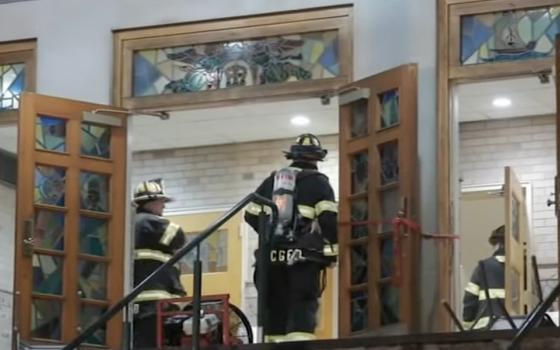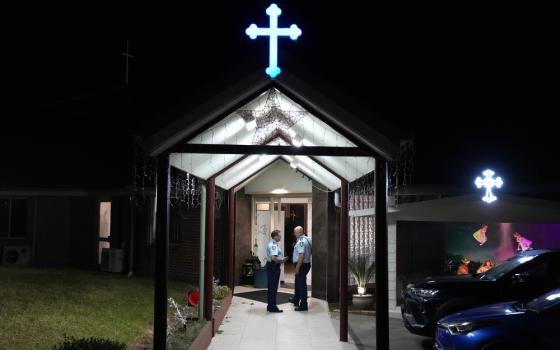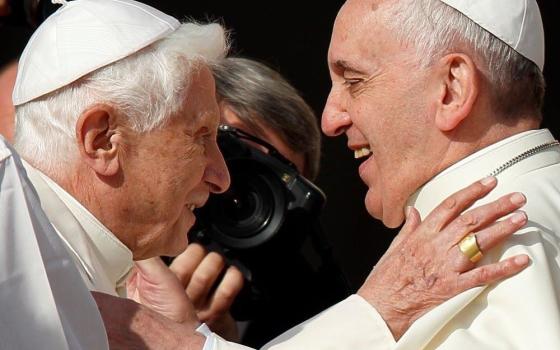One way to detect what’s bubbling in the church is when a subject keeps coming up, even in a venue not naturally designed to elicit it. For instance, it’s no surprise the Latin Mass was discussed at the 2005 Synod of Bishops on the Eucharist, but if it were repeatedly surfacing under the heading of New Evangelization, that might be a better sign of popular interest. (For the record, it’s not.)
The ferment over Islam in the Oct. 7-28 Synod on New Evangelization is thus compelling evidence that it’s much on the minds of Catholic leaders these days.
After a rowdy discussion Saturday night set off when Cardinal Peter Turkson of Ghana, president of the Pontifical Council for Justice and Peace, used his “free discussion” time to show an alarmist Youtube video on Muslim demographics, the topic came up again yesterday. (As a footnote, Turkson apologized to the synod last night, saying he "never meant to call Christians to arms" and didn't mean to cause harm, but noted that it did at least prompt a lively discussion.)
Bishop Jean-Baptiste Tiama of Mali reported that just three to five percent of his country is Christian, surrounded by an overwhelming Muslim majority. The situation was basically “peaceful and stable”, he said, until 2011, when a rebellion “helped by the Islamist movements armed and supported by Al Qaeda” broke out in the north.
Today, Tiama said, “this movement occupies two-thirds of the country and threatens democracy and the existence of other religions”, and it also “extols the establishment of Islamic law in the entire country.”
In that context, he more or less hinted, evangelization faces a steep uphill climb.
Cardinal Francesco Coccopalmerio, an Italian who heads the Pontifical Council for the Interpretation of Legislative Texts, made a strong case that the New Evangelization has to have a strong ecumenical imprint – in part, he said, because the divisions among Christians are a large part of the reason for the progressive “de-Christianization” of Europe.
At the end, Coccopalmerio added that greater solidarity among Christians “would also present an extraordinary sign to Islam” – apparently suggesting that it might act as a firebreak against fears of a Muslim “takeover” in Europe.
Bishop Sebastian Francis Shaw of Pakistan described the situation in his country under its notorious “blasphemy law,” which effectively makes it illegal to convert from Islam to another religion. He thanked Pope Benedict XVI and other leaders who interceded on behalf of Asia Bibi, a 41-year-old Pakistani woman who converted to Christianity and was sentenced to death by hanging. Public criticism of that verdict cost the life of Shahbaz Bhatti, a devout Catholic layman who had been Pakistan’s only Christian member of the cabinet, and Muslim politician Salmaan Taseer.
Shaw said that the church is committed to building bridges with the country’s Muslim majority.
“In spite of fundamentalist challenges to our Catholic faith in Pakistan, we in the church through interreligious dialogue invite Islamic scholars and civil society, and other religious minorities, to endeavor to build up a harmonious society in which all Pakistanis could live the common religious values which we profess together, such as justice, peace, respect for environment, good governance with reciprocal love and concern,” Shaw said.
Bishop Emmanuel Adetoyese Badejo of Nigeria likewise stressed the importance of engaging Islam – in part, he said, because in his country, many Christians come from Muslim families and have Muslim relatives.
At times, Badejo said, “it’s easier to dialogue with Muslims than with Islam.”
Bishop Gabriel Akwasi Ababio Mante of Ghana, where Turkson is from, listed “militant Islam” among the challenges his church faces.
“Islam in Ghana has so far not posed any open threats to the Catholic church and other ecclesial communities,” Mante said. “In fact, both sides enjoy good relationship and collaborate on major socio-political issues. However, one wonders whether there are no negative currents under this good relationship, and therefore the prevailing situation should not be taken for granted.”
Archbishop John Wong Soo Kau of Malaysia pointed to the need to defend embattled Christians living in predominantly Muslim zones.
“We need to ensure that the basic rights of Christians as minorities in certain regions need first to be protected and their faith be strengthened,” he said. Malaysia, by the way, is a country of 28 million that’s slightly more than sixty percent Muslim, with Christians at about ten percent.
Overall, the thrust of the synod’s discussion on Islam might be summed up this way: The church needs to get its facts right, resist histrionics, and shouldn’t be launching some new crusade. At the same time, it needs a more robust capacity to push back against Islamic extremism, especially when Christians find themselves in the firing line.
* * *
In a session with reporters yesterday, Cardinal Timothy Dolan of New York noted the irony that in countries where the Catholic church is materially poor, it’s often thriving spiritually – full churches, booming vocations, and so on. Meanwhile, Dolan said, materially prosperous nations often face rather serious spiritual deficits.
At face value, that would suggest a rather obvious two-way exchange: Materially poor churches share some of their spiritual goods in exchange for material support. Recently, two African bishops hinted at what one form of that material support might look like.
Auxiliary Bishop Benjamin Phiri of Zambia gave a speech Saturday evening that struck participants for its candor, acknowledging that sometimes the African church puts poorly trained priests in the field simply out of the urgent need to fill slots, with the result that they “become bad shepherds rather than good shepherds, scattering instead of gathering the sheep.”
Part of the reason, Phiri said, is that the burgeoning number of candidates for the priesthood isn’t matched by an equal number of formation personnel with the appropriate academic, spiritual and human qualifications.
It’s a point echoed yesterday by Archbishop William Slattery of South Africa, who wondered aloud whether, “with few trained formators in many seminaries, if seminarians personally encounter the Lord?”
“If young priests come out with poor human formation, they will be unsympathetic and unable to make people belong,” Slattery said.
The logic here seems fairly obvious, though no one has quite drawn the conclusion out loud: Given the increasing dependence of Europe and North America on imported priests from Africa, perhaps Western bishops ought to be more aggressive in releasing some of their best personnel to offer formation in African seminaries.
That point builds on an observation made early on in the synod by Cardinal Polycarp Pengo of Tanzania, who observed that the growing number of African priests serving abroad risks a damaging “brain drain” at the expense of the churches back home.
Even if those matters of justice aren’t exactly resolved by the end of the synod, they’re at least now a part of its record.
* * *
Speaking of topics that haven’t come up, here’s a rather striking omission at the synod: So far, nobody’s said anything about deacons.
In the abstract, suppose somebody told you that there’s a corps of 40,000 Catholics out there ready to go to work for the New Evangelization, who have received something like five or six years of hard-nosed formation specifically to equip them to preach the gospel in the modern world, and who can represent the church in an official capacity as ordained ministers. It’s hard not to think that ought to be a fairly significant resource for whatever the “New Evangelization” will end up looking like in practice.
At least in theory, this is exactly what the permanent diaconate is designed to be. Deacons are ministers of the church specifically charged with preaching the gospel, and because most of them are married and have jobs, they’re also ministers with one foot solidly in the secular world – the front lines of where the New Evangelization is supposed to unfold.
Yet so far at the synod, the silence about deacons has been deafening. So far, in the official summaries of synod speeches released by the Vatican Press Office, the word “family” has been mentioned 126 times, “parish” 92, “media” 65, “movements” 37, and some version of “small,” “base,” or “basic communities” 36. Yet the word “deacon” has been invoked only six times, and two of those were because Cardinal Angelo Sodano identified himself as the oldest bishop-deacon in the synod, one was as reference to Philip in the Acts of the Apostles, and the other three were toss-away mentions of “priests and deacons.”
To date, no one has offered any systematic reflection on the role deacons might play, which is especially odd given that in 2000, Pope John Paul II gave an entire speech titled “Deacons as Apostles of the New Evangelization.”
I contacted American Deacon William Ditewig, who served as the U.S. bishops’ staffer on the diaconate and is now involved in building an international study center based at Rome’s Lateran University, for his take on why deacons ought to be at the core of the New Evangelization.
“Deacons are charged in a special way with presenting the gospel of the church to all,” he said. “This is reflected throughout the tradition and is celebrated sacramentally at the deacon’s ordination. This proclamation is linked to the care of the people in every walk of life. Since deacons are able to live and move in circles that other ‘sacred ministers’ cannot, then we can be particularly effective in projecting the gospel.”
In Ditewig’s recent book 101 Questions and Answers on Deacons, he describes a statewide meeting where somebody asked a bishop what role he saw for deacons in the next five to ten years. As Ditewig recounts the exchange, the bishop replied that there was a region in his diocese with almost no Catholics that’s known for anti-Catholic attitudes. The bishop said his plan was to “let loose the deacons” in that area, and within five to ten years, he expected the church to be thriving.
One intriguing question about the synod thus becomes: Is anybody going to propose letting the deacons loose?




